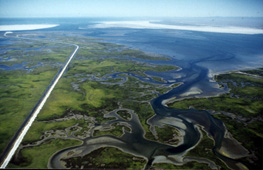Gray Whale Migration
Winter: December, January, February
In the Mating and Calving Lagoons
| Gray
Whale Nursery Lagoons |
Since December, gray whales have been arriving in the four calving and mating lagoons of Mexico's Baja California coast. (Click on the map dots to read more about each lagoon.) Most of the births occur from early January to the end of February, although a few babies each year are born during their mother's migration south.
The pregnant
females and those with calves concentrate in the inner lagoons, farthest
from the open sea. A newborn gray whale calf is around 15 feet long
at
birth and weighs from 1500 to 2000 pounds. In some cases, another gray
whale called an auntie helps during the birth. The auntie may help
hold
the
mother above the water so the baby can be born headfirst into the air.
The auntie or the mother will also push to the surface a calf born
underwater
so this baby mammal can take its first breath of air. Within minutes
the baby is gaining strength and swimming. It has a lot of growing
to do in
the next 2-4 months, when it will need to swim the 5000 miles (or more!)
to its summer home and feeding grounds.
 |
Gray
Whale Nursery Lagoons Photo Courtesy of Keith Jones |
A new baby gray's flukes and flippers are very floppy at first. Later they'll become rigid, but for now it is very difficult for these newborns to swim fast enough to keep up with an adult. The mothers move very slowly. They are very protective of their young. Once their flukes and flippers have gained strength, the calves begin to explore the lagoon. Mothers carefully swim with their babies around the lagoon.
The warmer waters of Baja Mexico's shallow lagoons are ideal nurseries. The warmer water helps newborns to conserve body heat—a good thing because they are born lean and fairly blubberless. The calves nurse for around 6 months, during which time the mother provides up to 50 gallons of milk each day. The thick, rich milk contains 53% fat, helping calves gain 60 to 70 pounds or more—daily! They are building up blubber for their cold trip north.
|
|
| Clip:
Kissing Baby Whale |
Meanwhile, whales in the lagoons continue to enchant and entertain hundreds of visiting whale watchers. Tour guide Keith Jones says: "We have been blessed with one trip after the other where whales come right up to the boat." Do you wonder what it would be like to float in the panga (boat) and have a huge gray whale mother and her curious baby glide up to or under it? Some lucky teens from Knoxville, Iowa show what it’s like. If you can't imagine kissing a baby whale, be there with our video clip!
By the end of December or first of January, gray whales are traveling both ways. A few of the earliest arrivals in the lagoons—males who are done mating and whales too young to mate—are already starting their journey north. Into February gray whales are still plowing south in bigger numbers than the few whales heading north. But usually by mid-February to early March, the migration reaches a point called the turnaround: more whales are headed north than south. For most gray whales, the urge to migrate south fades in mid-February. (Whales going south in March and April are probably just detouring temporarily from the northbound migration. Could they be turning back to look for other whales they had been traveling with earlier?)
By mid-February, newly-pregnant females leave the lagoons to begin the northward migration. They are soon followed by the males and the juveniles of previous years. Last to leave are the new mothers and their calves. They sometimes stay as late as May or June.
Winter Lessons
-
Holy Cow! What a Calf Mom and Baby in the Lagoon. Photo Keith Jones.
Mom and Baby in the Lagoon. Photo Keith Jones.
What do newborn calves look like? About how much will a calf gain by the time it's two months old and begins the migration north? What clues say gray whales make good mothers? - Life
in the Nursery Lagoons.
What makes the lagoons such good nurseries for newborn whales? Close your eyes and picture the scene as tour guide Kristin "Ellie" Kusic describes moms and babies in Laguna San Ignacio from aboard a whale watch tour boat. - Whale
Art: Draw a Gray Whale
Just how big are these ocean-going mammals? Draw a life-size gray whale with our step-by-step directions. - Lagoon
Tour: Whale Watching at Laguna Ojo de Liebre
Would you like to visit some whales? Join us on a photo tour of Laguna Ojo de Liebre, one of the four nursery lagoons on Mexico?s Baja Peninsula. What is a whale "footprint" and what does it tell you? What are two facts about the barnacles on gray whales? About how many weeks do whales swim to get from the Arctic to the lagoons of Mexico? What is the name of the area in Mexico set aside to protect endangered plants and animals? What is the world's longest and narrowest peninsula? Find out here! - Rules!
Rules! Rules!
Read the rules that whale watchers obey at Laguna Ojo de Liebre. Then have a discussion with our list of questions. - Salt
of the Earth
Warm and salty, the lagoons of Baja California Mexico are not just ideal nurseries for gray whale babies. These lagoons also offer just-right conditions for producing solar-evaporated salt. See where salt comes from in this photo tour. - Sheyna
Wisdom Listens to Whales!
Scientist Sheyna Wisdom is trying to find out how gray whale calves make their sounds. What ARE their sounds? find out more with our Q and A interview with Sheyna.




